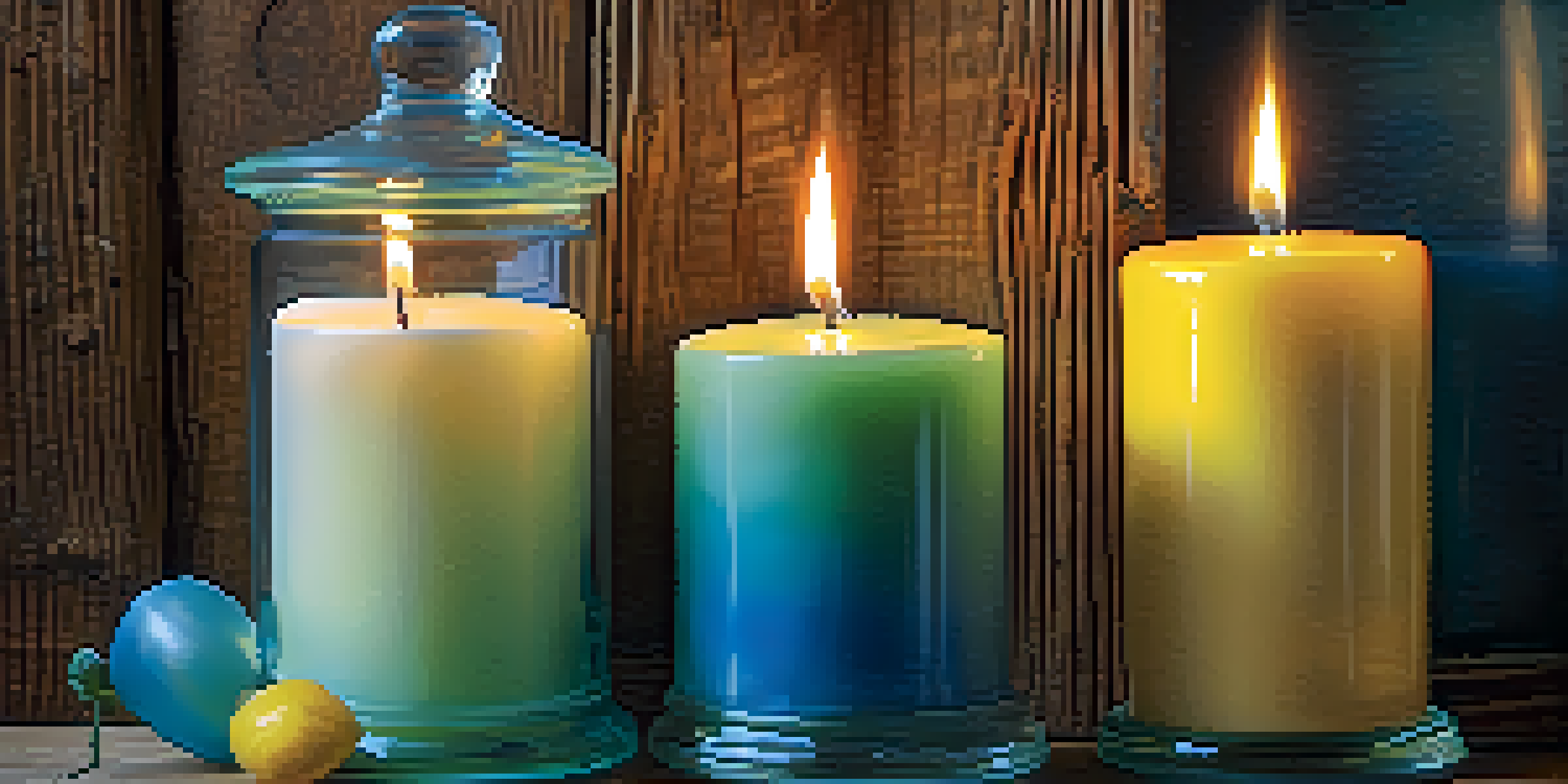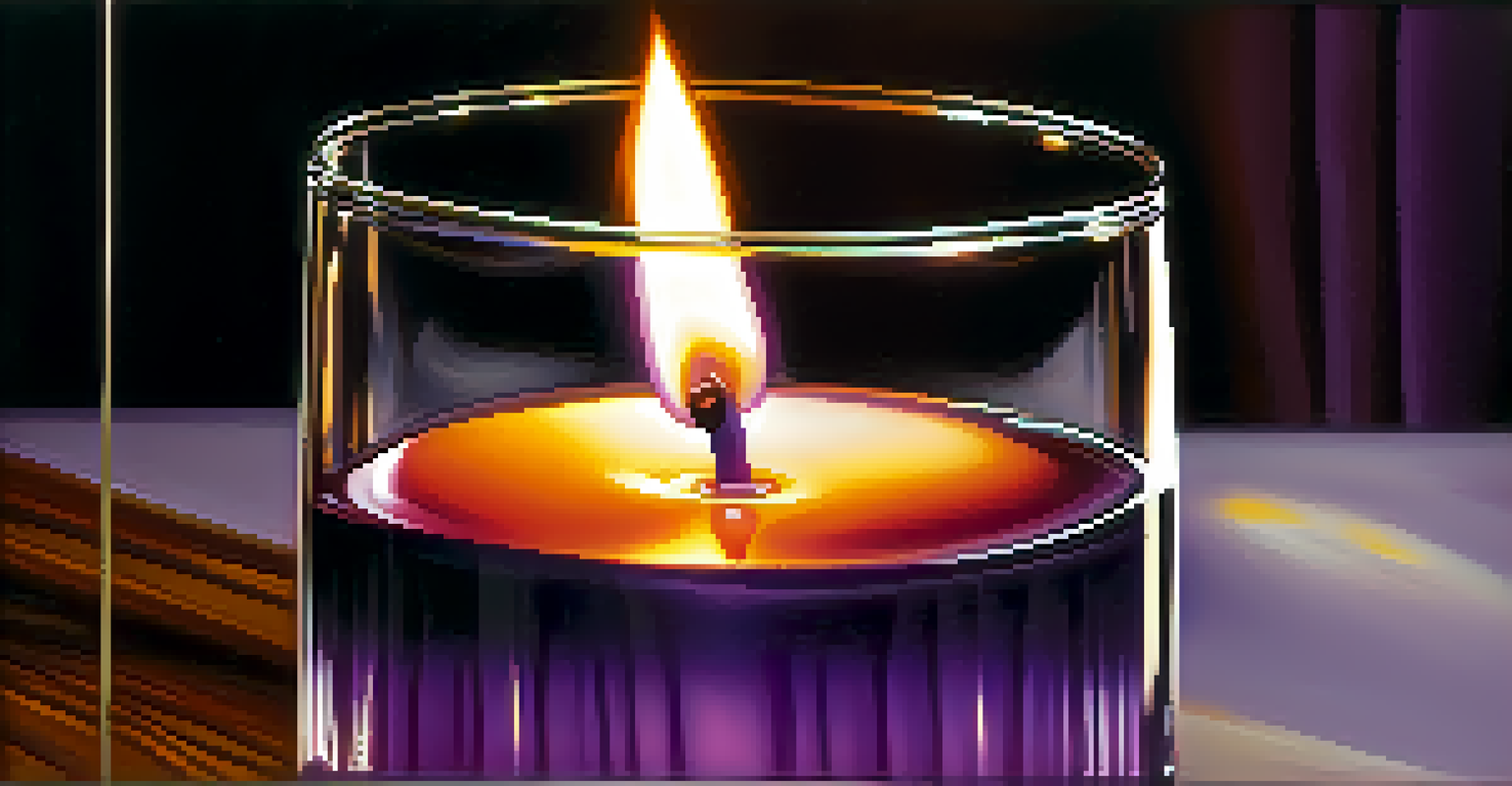Creating Layered Candles: Techniques for Stunning Effects

Understanding the Basics of Candle Making
Before diving into layered candles, it’s essential to grasp the basics of candle making. At its core, candle making involves melting wax, adding fragrance, and pouring it into a mold with a wick. This process can be both a science and an art, allowing for endless creativity. Understanding the properties of different waxes, such as paraffin or soy, can help you choose the right materials for your project.
Candle making is a beautiful blend of art and science, where creativity meets precision.
Different types of wax behave in unique ways, influencing the final look and burn quality of your candle. For instance, soy wax is popular for its clean burn and ability to hold fragrance well, while paraffin tends to be more traditional and readily available. Knowing these differences will guide you toward achieving the stunning effects you desire in your layered candles.
Once you're familiar with the basics, you can start experimenting with colors, scents, and layering techniques. The beauty of making layered candles is in the customization; you can create candles that not only look good but also smell fantastic. Let’s explore how to achieve those eye-catching layers.
Choosing the Right Wax for Layering
Selecting the right wax is crucial for creating beautiful layered candles. Soy wax, beeswax, and paraffin each have distinct properties that can affect your layering process. For instance, soy wax is great for holding color and scent, while beeswax offers a natural, warm glow. Understanding these characteristics will help you make the best choice for your layered designs.

When layering, it's important to consider the melting points of the waxes you use. If you're combining different types, ensure the wax with the lower melting point is poured last, as it needs to remain liquid longer to allow for a seamless blend. This knowledge helps prevent uneven layers and ensures your designs are visually appealing.
Master Candle Making Basics
Understanding the fundamentals of wax types and the pouring process is essential for creating stunning layered candles.
Additionally, you may want to experiment with blending different waxes to create unique effects. Some candle makers mix soy and paraffin to enjoy the benefits of both, achieving a beautiful appearance and strong scent throw. Remember, trial and error is part of the fun in the creative process!
Coloring Your Layers: Techniques and Tips
Color is one of the most exciting aspects of layered candles. You can create various effects by using different dyes and pigments, such as liquid dyes, color blocks, or natural colorants like herbs and spices. Each method yields a different intensity and look, so feel free to experiment until you find your favorite. Don’t forget to test colors on a small batch before committing to larger pours.
The joy of creativity is in the process, not just the final product.
When layering colors, it’s important to allow each layer to cool slightly before pouring the next. This helps prevent the colors from bleeding into one another, maintaining the distinct layers you aim for. You can also use a heat gun to gently warm the top of the previous layer if you want to create a slightly blended effect without losing all separation.
Consider implementing a gradient technique by transitioning colors gradually from one layer to the next. This can create a stunning ombre effect that adds depth and interest to your candle. The key is in the preparation and patience, so take your time to enjoy the process!
Fragrance Layering: Blending Scents Creatively
Fragrance layering can elevate your candle-making game, allowing you to create unique scent experiences. Start by choosing complementary scents that can blend well together. For instance, vanilla pairs beautifully with citrus, while lavender and eucalyptus create a calming aroma. Experimenting with different scent combinations will help you discover your signature blends.
When layering fragrances, add the scent to each layer before pouring. Just like with colors, it’s best to use a dropper for precision, ensuring that each layer holds its intended fragrance. Be mindful of the fragrance load—too much can overpower and alter the candle’s burn characteristics.
Choose Wax Wisely for Layering
Selecting the right wax and considering their melting points is crucial for achieving beautiful, distinct layers in your candles.
You can also create a surprise element by layering contrasting scents. Imagine lighting a candle that starts with a fresh, citrusy top layer, transitioning to a warm, comforting vanilla. The unexpected change can add a delightful experience for anyone who uses your candles, making them memorable and special.
Layering Techniques: Pouring and Setting
The actual pouring process is where your layered candle begins to take shape. Start by melting your first layer of wax and pouring it into your container, making sure to leave enough time for it to set before adding the next layer. This patience is crucial; rushing can cause the layers to mix and lose their distinctness.
To ensure a smooth transition between layers, aim for a slight cool-down period between pours. A good rule of thumb is to pour the next layer when the previous one is firm but not completely hard. This helps create a bond between the layers, improving the overall structure of the candle.
If you're feeling adventurous, try using a thermometer to monitor the temperature of your wax. This will help you know exactly when to pour each layer for the best results, especially if you are working with various wax types. Remember, achieving stunning effects takes practice, so don’t be discouraged if it takes a few tries to get it just right!
Creative Containers for Layered Candles
The container you choose can greatly impact the final look of your layered candles. From sleek glass jars to rustic tin cans, the options are endless. Consider the theme or ambiance you want to create; for instance, a mason jar can give a cozy feel, while a modern glass vessel may lend an air of sophistication.
Additionally, clear containers allow you to showcase the beautiful layers you’ve created. If you want to add an element of surprise, consider opaque containers that conceal the layers until the candle is lit. This can create a delightful reveal that adds to the sensory experience.
Experiment with Colors and Scents
Blending colors and fragrances creatively can elevate your candles, making them visually appealing and unique in aroma.
Don’t hesitate to get creative with your containers! Recycled items, like teacups or old jars, can add a unique touch to your candles. This not only helps the environment but also makes for great conversation starters when you gift or display your creations.
Troubleshooting Common Layering Issues
Even the most experienced candle makers encounter challenges, especially with layering. One common issue is uneven layers, which can happen if the wax isn’t allowed to cool enough before adding the next layer. If you notice this happening, take a step back and adjust your pouring technique.
Another issue can be the scents overpowering one another. It's essential to find the right balance when blending fragrances. If you find a particular layer too strong, consider diluting it with a neutral base wax or reducing the fragrance load in your next attempt.

Lastly, if you experience wax bleeding between layers, try adjusting your pouring temperature. Pouring at a lower temperature can help prevent this issue and preserve the integrity of your layers. Remember, every setback is a learning opportunity that will enhance your skills.